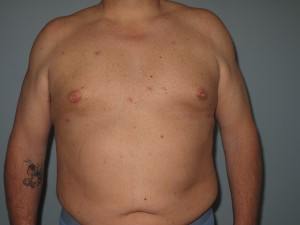The medical term gynecomastia refers to the development of firm breast tissue in males. Those who suffer from this condition may notice first tissue first developing under the nipple and spreading less than an inch across the region of the areola. Similarly, firm tissue may be distributed evenly or in fluctuating patterns across one or both breasts. For many who suffer from this condition, pain and tenderness of the affected area are reported.
While this condition is not considered life-threatening, men who develop gynecomastia are prone to an increased risk of male breast cancer. This is due to the rapid hormonal changes associated with gynecomastia that may betray underlying conditions closely linked to cancer development.


It is important to note that gynecomastia is separate but often occurs in combination with conditions known as false gynecomastia or pseudogynecomastia. Male patients who suffer from false gynecomastia present with localized fat deposits in the chest area that closely resemble female breasts. Much unlike gynecomastia, tissue buildup for patients with false gynecomastia is soft while gynecomastia presents as firm tissue in the affected areas.
Men and younger boys who develop gynecomastia are prone to fluctuating feelings of shame or embarrassment associated with the visible symptoms of this condition. Combined with the physical pain associated with tissue buildup, many patients are quick to seek gynecomastia treatment options.
Causes Linked to the Development of Gynecomastia
There are several potential factors linked to the development of gynecomastia and patients suffering from the condition may be able to pinpoint one or several of these causes as contributing elements. A primary factor leading to the potential development of gynecomastia is fluctuating hormone levels. While hormonal fluctuation is normal for both men and women throughout the natural aging process, males who experience an extreme spike in estrogen levels are more likely to develop gynecomastia. Similarly, there are several health conditions that provoke extreme hormone fluctuation, including excessive weight gain, chronic renal failure, pituitary insufficiencies and androgenic steroid use. Men who suffer from one or more of these conditions are likely to experience estrogen increases leading to the development of gynecomastia.
Some patients suffering with gynecomastia report regularly using supplements and products heavily saturated with plant oils including tea tree oil, dong quai, terrestris and lavender prior to developing the condition. Medical experts point at the natural presence of estrogen in these products as a possible cause for the development of gynecomastia in males.
Beyond hormonal fluctuation, patients who regularly participate in the use of recreational drugs such as amphetamines, heroin and other opiates have seen an increase in gynecomastia development. Excessive alcohol use has also been noted as contributing to the development of the disease. The development has also been linked to certain prescription antibiotics, ulcer and heartburn mediations as well as ACE inhibitors, human growth hormones and anti-anxiety medications. The effects of chemotherapy may also put an individual at a heightened risk for developing this condition.
Medical Treatment Options for Gynecomastia
While the probable causes may be vast, so are the medical options when it comes to treating gynecomastia. It’s important to note that males suffering from gynecomastia during puberty will often notice the condition disappearing on its own within 6-months to a few years following this period of life. For conditions that do not dissipate over time, there are a number of gynecomastia treatment options available.
Testosterone replacement is an ideal solution for men with gynecomastia that suffer from reduced testosterone levels as well. Many physicians recommend this method for minimizing the painful physical symptoms associated with the condition. Danazol is a common synthetic derivative of testosterone that inhibits the pituitary secretion of substances that provoke reproductive organs to produce hormones and may be prescribed by an attending physician.
Surgical Treatment Options
When medicinal solutions aren’t enough to reverse the symptoms associated with gynecomastia, a physician may recommend a surgical solution. Breast reduction surgery is a method of removing fat tissue from the chest area in the event that drug therapies have proven ineffective. Similarly, a mastectomy may be a necessary step to successfully and completely remove excessive breast gland tissue.
Taking the First Steps Toward Treatment
The team at the St. Louis Laser Lipo and Vein Center is here to provide patients with a comprehensive and personalized gynecomastia treatment plan. When you’re ready to explore the many solutions to treating gynecomastia, take time to schedule an initial consultation with Dr. Wright. After a review of your complete medical profile, you’ll be able to discuss procedural specifics and have all of your questions and concerns answered up front. The decision to undergo cosmetic services is a personal one, and we’re here to help make the process as stress free as possible. Contact us to schedule an initial consultation or discuss the variety of services we provide. For those interested in financing options to cover the cost of care, our professional staff is here to help answer your questions.